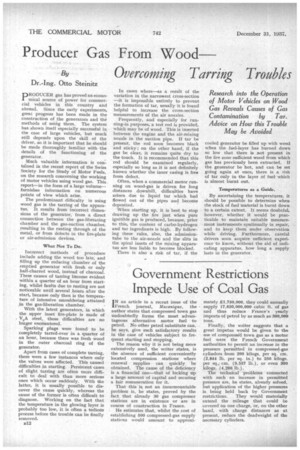Producer Gas From Wood Overcoming Tarring Troubles
Page 24

If you've noticed an error in this article please click here to report it so we can fix it.
Research into the Operation of Motor Vehicles on Wood Gas Reveals Causes of Gas Contamination by Tar. Advice on How this Trouble May be Avoided By Dr.-Ing. Otto Steinitz
PRODUCER gas has proved an economical source of power for commercial vehicles in this country and abroad. Since the early experiments, great progress has been made in the construction of the generators and the methods of using them. The system has shown itself especially successful in the case of large vehicles, but much still depends upon the skill of the driver, so it is important that he should be made thoroughly familiar with the details of the functioning of the generator.
Much valuable information is contained in the recent report of the Swiss Society for the Study of Motor Fuels, on the research concerning the working of motor vehicles using wood gas. This report--in the form of a large volume—. furnishes information on numerous points of view which arise.
The predominant difficulty in using wood gas is the tarring of the apparatus. It results from incorrect dimensions of the generator, from a direct connection between the gas-liberating chamber and the gas-suction chamber, resulting in the rusting through of the metal, or from defects in the fire-plate or air-admission devices.
What Not To Do.
Incorrect methods of procedure include adding the wood too late, and filling up the reducing chamber of the emptied generator with fresh or only half-charred wood, instead of charcoal. These causes of tarring become evident within a quarter of an hour from starting, whilst faults due to rusting are not noticeable until several hours after the start, because only then is the temperature of intensive smouldering attained in the gas-liberation chamber.
With the latest generators, in which the upper inset fire-plate is made of .
112A steel, these difficulties are no longer encountered.
Sparking plugs were found to be completely tarred-over in a quarter of an hour, because there was fresh wood in the outer charcoal ring of the generator.
Apart from cases of complete tarring, there were a few instances where only the valves were affected. This caused difficulties in starting. Persistent cases of slight tarring are often more difficult to deal with than more serious ones which occur suddenly. With the latter, it is usually possible to discover the cause quickly, whereas the cause of the former is often difficult to diagnose. Working on the fact that the temperature in the glowing layer is probably too low, it is often a tedious process before the trouble can be finally removed.
E1.2
In cases where—as a result of the variation in the narrowest cross-section —it is impossible entirely to prevent the formation of tar, usually it is found helpful to increase the cross-section measurements of the air nozzles.
Frequently, and especially for running-in purposes, a test rod is provided, which may be of wood. This is inserted between the engine and the air-mixing nozzle in the suction pipe. If tar be present, the rod soon becomes black and sticky ; on the other hand, if the gas be clear, it remains quite dry to the touch. It is recommended that this rod should be examined regularly, especially so long as it is not definitely known whether the inner casing is free from defect.
Often, when a commercial motor running on wood-gas is driven for long distances downhill, difficulties have arisen due to liquid tar which had flowed out of the pipes and become deposited.
When starting up, it is best to stop drawing up the fire just when pure ignitible gas is produced, because, prior to this, the content of carbo-hydrogen and tar ingredients is high. By following these rules, also, the admissiontube to the air-nozzle and the slits in the spiral insets of the mixing apparatus are less liable to become blocked.
There is also a risk of tar, if the
cooled generator be filled up with wood when the fuel-layer has burned down so low that there is not present in the fire zone sufficient wood from which gas has previously been extracted. If the generator be hot, and can be set going again at once, there is a risk of tar only in the layer of fuel which is almost burnt out.
Temperatures as a Guide.
By ascertaining the temperatures, it should be possible to determine when the stock of fuel material is burnt down to a certain extent. It seems doubtful, however, whether it would be practicable to maintain suitable measurement instruments continually in repair, and to keep them under observation while driving. Furthermore, careful drivers soon acquire sufficient experience to know, without the aid of indicating apparatus, how long a supply lasts in the generator.
































